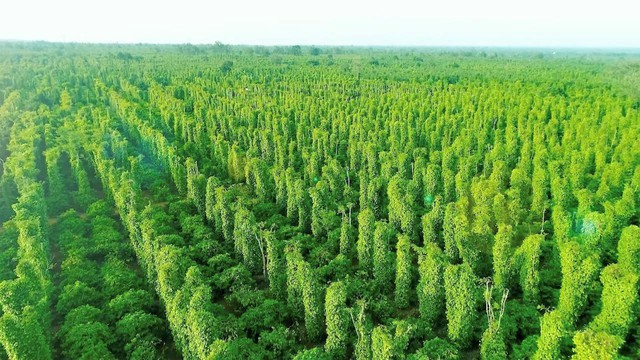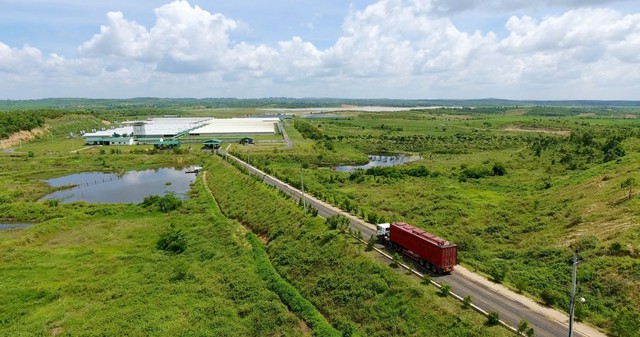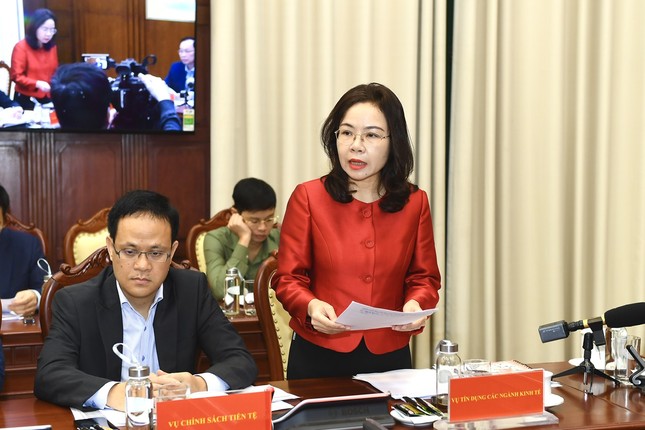
Vietnam has great potential for developing a dynamic, high-quality and efficient carbon market – Photo: VGP/MT
Experience in developing the global carbon market
Mr. Bui Duc Hieu, Deputy Head of the International Cooperation Department (Ministry of Natural Resources and Environment), said that the carbon credit market operates very actively around the world, on all continents. However, in each country, the methods and timing of operation are different.
The European Union is the first place to implement the carbon market the earliest in the world, operating in 2005, and has gone through 5 phases so far. South Korea’s market operated on a trial basis in 2012, officially in 2015 and went through 3 phases. China’s market operated on a trial basis in 2012 in some provinces and officially nationwide from 2022. Other countries, such as the UK in 2021, and Japan, have just finished testing and officially started operating from April 2023.
There are 3 forms of carbon market operation in the world: mandatory, voluntary, and compliance with Article 6 of the Paris Agreement. In addition, there is a form not included in the above 3 types, relatively simple, just listing on the stock market. Singapore is implementing this form.
Regarding the price of carbon credits, according to Mr. Bui Duc Hieu, in the form of compliance with Article 6 of the Paris Agreement, there will be no price for carbon credits. The price of carbon credits is only available in the first form and the second form, priced through auctions or trading on the market. The price of carbon credits currently depends on supply and demand, depending on the production and business situation of enterprises, sectors, emission areas. In South Korea, transactions are currently around 5-6 USD/credit, Australia 25 USD, China 10 USD, etc.
Regarding the operation of the carbon credit trading floor, Mr. Bui Duc Hieu said that among the above countries, only South Korea is early in Asia. Other countries, such as Japan, China, Southeast Asian countries, or South American countries and many other countries are also in the process of preparing to operate like Vietnam. That is, setting a target to operate the trial operation of the carbon credit trading floor in 2025, officially operating in 2028. Some countries may speed up this process by 1-2 years.

Participating in the carbon market will enhance the brand of enterprises, thereby helping enterprises have more advantages in negotiations and exporting products – Photo: VGP/MT
Creating development opportunities for businesses
Vietnam’s compliance carbon market is in the construction phase. Vietnamese enterprises have exchanged carbon credits in the voluntary carbon market worldwide nearly 20 years ago. In the context of green conversion, low-carbon economic development toward a circular economy has become an inevitable trend, building, operating and developing the carbon market become increasingly important tools.
Up to now, Vietnam has had 150 projects granted 40.2 million carbon credits and is one of the 4 countries with the most registered clean development mechanism investment projects. Vietnam has great potential for developing a dynamic, high-quality and efficient carbon market.
Vietnam is a developing country with a large open economy. If we apply the carbon market early, it means that enterprises have to reduce emissions, which will have a great impact on the economy. Although businesses have to spend a lot of costs to convert technology, switch to green development, for individual businesses and the overall economy, it cannot be slower, it needs to be transformed, otherwise it will lag behind the world.
In terms of macro benefits, reducing emissions, and participating in the carbon market, is together with the Government to implement international commitments in emissions reduction. Contribute to environmental protection against the impact of climate change.
Furthermore, when participating in the carbon market, green finance will certainly enhance the brand of the enterprise, thereby helping the enterprise have more advantages in negotiations and exporting products.
Not only that, reducing emissions is also an opportunity for businesses to change their production models, technologies. Thereby creating credits to sell to the market, earning profits. A typical pioneering business in the world that has a long-term vision is Tesla (USA). In 2022, this business sold carbon credits, earning 1.78 billion USD, accounting for 10% of total profits.
Speaking of opportunities for Vietnamese businesses to participate in the development of a low-carbon economy, Mr. Nguyen Quoc Khanh, Chairman of the Ho Chi Minh City Handicraft and Wood Processing Association (HAWA), said that Vietnam has 14.2 million hectares of forests, accounting for 42% of the country’s land area, including 7 million hectares of planted production forests. With this natural forest area and planted production forest, if efficient management is demonstrated, demonstrating biomass growth and emission reduction, this is the abundant carbon credit source. Recently, Vietnam received more than 41 million USD (equivalent to 10.3 million carbon credits) from the World Bank for forest carbon credit transfer.
Therefore, according to Mr. Khanh, besides the huge challenges for the wood industry to participate in the carbon market, the opportunities are also not small, but also create a premise for the development of a circular economy.
Because, the wood industry benefits from the trend of using wood materials as a replacement for materials with high emissions such as metals, plastics, and concrete… In addition, wood is not only used in interior products as before, but will have great opportunities in construction with mass timber. Furthermore, wood-based materials will also be widely used in the renewable biomass energy industry, consumer goods, packaging… due to low emissions, easy decomposition, and recycling.
“With negative emissions capabilities, the timber industry and especially forestry can achieve a volume of carbon credits to offset other industries,” Mr. Khanh affirmed.
Recently, on January 24, 2024, within the framework of the Conference on calling for investment for green growth development in Ho Chi Minh City, Mr. Mani Mathukumara, Chief Expert on Economic and Environmental Affairs of the World Bank (WB), said that for Vietnamese businesses to participate in international carbon credit market transactions, first, businesses must have ideas, projects, then bring these projects, ideas to verification units, and these units simultaneously provide financial sources, partners to participate in trading credits in the market.
Currently, WB is also performing this function and WB’s cooperation and support to Ho Chi Minh City in creating mechanisms to connect with verification units as well as connecting supply and demand for carbon credits will also be a great opportunity for Vietnamese businesses to participate in this potential carbon credit market.

Developing the green finance market, in which the carbon market is key, will be the key to successful green conversion – Photo: VGP/MT
The key to successful green conversion
Mr. Le Xuan Nghia, Director of the Carbon Financial Consulting Institute (CODE), said that green economy, carbon economy, carbon market… are not only environmental issues, but today they are becoming a trend of the economic era. In the future, transparently informing reports on emissions, carbon indexes… will certainly be mandatory. For example, when a business is listed on the stock market, in addition to financial reports, the company must have a report on quantifying, inventorying its greenhouse gas emissions.
In addition, green conversion is a new driving force for rapid and sustainable growth. “Green” standards are being shaped and pushed to be implemented towards commercial and international investment with criteria for reducing carbon emissions, sustainable development, labor and the environment. Along with that, new links and green-related initiatives are also being strongly promoted.
Therefore, developing the green finance market, in which the carbon market is key, will be the key to successful green conversion. This is a key moment for Vietnam to establish, constantly increase its position in global green value chains.
To achieve the goal of sustainable development, Vietnam has issued many important strategic documents on green growth and development, including the roadmap for developing carbon pricing tools, especially the compliance carbon market. First, Vietnam plans to accelerate the construction of regulations on carbon credit management, operation of emission trading quotas; guiding the implementation of domestic and international carbon credit exchange and offset mechanisms in accordance with the provisions of laws and international conventions, and pilot a carbon credit trading floor from 2025.
Representatives of international environmental organizations have evaluated that the Vietnamese Government has relatively good preparation from the public sector. However, to promote the low-carbon economic development process, attention should be paid to approaching multiple parties, enhancing cooperation between sectors, fields, and levels. Especially strengthening the participation of the private sector, creating conditions for the development of supply and demand in the carbon market.





































